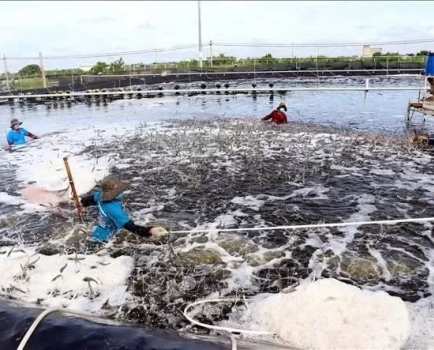Market Trends and Green Transformation for Vietnamese Firms
Thu, 02 Jan 2025 21:41:00 | Print | Email Share:
Green manufacturing is now a necessity, as Vietnam's trade partners have imposed new requirements, requiring businesses to adopt green standards for exports.

Greening trends in many fields
Dr. Nguyen Minh Thao, Director of the Business Environment and Competitiveness Department, the Central Institute for Economic Management (CIEM) under the Ministry of Planning and Investment, said that green manufacturing is a global trend and an inevitable choice for businesses today, especially when Vietnam joined many free trade agreements (FTAs) which include requirements for the implementation of environmental commitments and sustainable development and create a new framework for environment to bind parties' obligations to environmental protection. Vietnam also entered the United Nations Framework Convention on Climate Change (COP26 and COP28), aiming to achieve net zero emissions by 2050.
Green manufacturing is now an inevitable requirement because Vietnam's trading partners recently introduced new requirements, typically the European Green Deal (EGD). This is a comprehensive and long-term program of the European Union (EU), aiming to respond to global climate emergencies until 2050.
EGD was adopted on January 15, 2020. However, from January 2020 to October 2023, the EU took 58 green policy actions or expected to exert direct impacts on foreign goods imported into this region.
In addition, according to Thao, there are some green policies that affect merchandise exports of Vietnamese companies to the EU, including the Carbon Border Adjustment Mechanism (CBAM), the Farm to Fork Strategy, the Circular Economy Action Plan, and the EU Biodiversity Strategy for 2030.
Strong impacts on Vietnamese businesses
All importers and manufacturers of imported products (under the scope of regulation) outside the EU are also affected by CBAM, especially those in construction, machinery, automobile, railway and equipment, chemical and agricultural sectors, he said.
Currently, Vietnamese exporters to the EU market are less affected by the products and the export value of products regulated by CBAM is insignificant. Nonetheless, the EU's application of CBAM will, in the short term, affect four exports of Vietnam to the EU, namely steel, aluminum, cement and fertilizer. According to statistics, from 2017 to 2021, Vietnam’s total steel and aluminum exports to the EU market are valued at about US$1.1 billion and US$48 million a year. In 2022, the EU’s steel imports from Vietnam reached US$2.1 billion while its spending on Vietnamese aluminum was US$65.18 million. Given the small number of items and low export value, the impact is not large, estimated to decrease by about US$100 million in the coming time.
Notably, the scope of CBAM can be expanded, including indirect carbon emission tax and many products that emit a lot of carbon into the environment such as organic chemicals and polymers (plastics) and finally all goods regulated by the EU Emissions Trading System (EU ETS). After the EU’s Carbon Border Adjustment Mechanism, the US, Japan, South Korea, China and other countries will also apply a similar mechanism to collect CO2 duty on imported goods. As these are major export markets of Vietnam, Vietnamese companies will certainly be affected in the coming time.
Vietnam is currently the 11th largest import partner of the EU. Therefore, many Vietnamese industries exported to the EU market will be hurt by green policies.
In particular, seven groups of Vietnamese exports are forecasted to be affected by EGD: Electrical, electronic, information technology, machinery, equipment and related components; agricultural products (especially coffee, cashew nuts, pepper, cocoa and meat), seafood, timber and wooden products; foods (especially organic food); textile-garment and leather-footwear; chemicals, fertilizers, batteries and accumulators; iron, steel, aluminum and cement; and packaging (especially food packaging and chemical packaging.)
Notably, agricultural products, foods, textiles and garments are potentially exported with high value to the EU and likely imposed EU green policies. The EU’s green policies applied to these product categories are considered complicated and challenging because they cover all agricultural, food and apparel products (not some specific products in these categories). In addition, green policies are legislated in the form of mandatory minimum legal requirements (not recommended incentives for implementation). At the same time, these policies include standards, measures and regulations that affect many stages in the production chain (from design to input, from production and farming to transportation, from use to repair, from disposal to recycling, etc.) and not just applied to final products.
For the textile and garment sector, the EU has been a leading export market for Vietnam’s textile and garment products which are attributed to be the biggest causes of environmental degradation and climate change. Therefore, this category is most targeted by the EU’s green efforts. Accordingly, some green policies can be expanded to textile and garment products such as the Industrial Emissions Directive, the Textiles Ecosystem Transition Pathway, the Commitment to Sustainable Consumption and CBAM.
Order of the market
The EU's green policies will create opportunities for businesses to use clean technology, expand the market and integrate clean technology. However, according to Dr. Thao, challenges for Vietnamese businesses are huge.
Green policies are numerous in quantity, complicated in nature, and continuously evolving over time. There is no common set of green standards, no unified green transition roadmap for all types of exports. It requires the capacity to transform technology, control the supply chain, labor skills, accountability, declaration and information storage, so Vietnamese businesses must raise awareness, invest money and have governance capacity.
Dr. Nguyen Minh Thao believed that, to meet the increasingly demanding requirements of import partners, the Government and state agencies need to provide and update information promptly and issue specific implementation guidelines for the business community. It is necessary to coordinate, negotiate and dialogue with trade partners to discuss implementation methods and perfect the policy framework on decarbonization such as phasing out coal power, promoting renewable energy and saving energy. At the same time, it is necessary to construct regulations on carbon pricing, perfect the legal basis for green taxonomy, develop a green financial system, design and implement policies to support enterprises in green manufacturing.
Enterprises need to actively learn about green agreements, regularly update green policies on exports, make early preparations and take quick actions. In particular, they need to enhance their capacity such as capital, technology, engineering, human resources and governance; control emissions across the entire production chain, reduce emissions in each production stage and limit the use of environmentally unfriendly products; optimize the use of equipment and products; and increase production efficiency, effectively use resources and materials.”
The transition to green manufacturing is no longer a choice but a mandatory requirement, a market order,” Thao affirmed.
By: Anh Mai, Vietnam Business Forum
Source: https://vccinews.com/news/59851/market-trends-and-green-transformation-for-vietnamese-firms.html
---------------------------------------------
Same category News :












